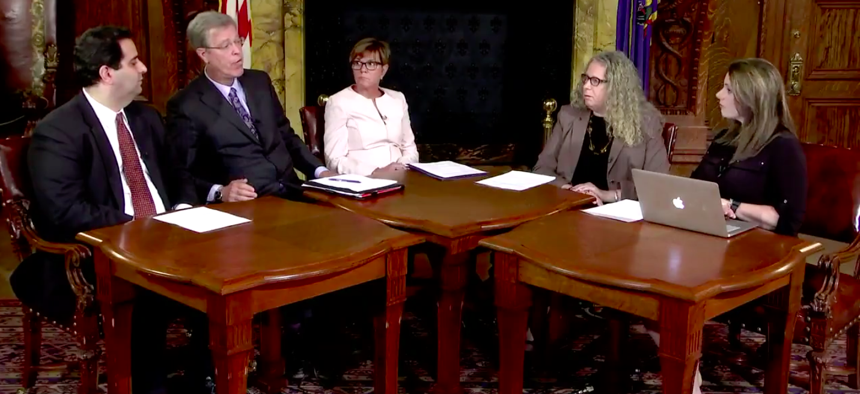In Opioid Abuse Fight, Pennsylvania Tries Out New Tool: Facebook Video

Members of Pennsylvania Gov. Tom Wolf's administration gathered on Monday to discuss the state's opioid abuse crisis on Facebook. Commonwealth of Pennsylvania via Facebook Live
In a crowded media ecosystem, can dialogue on state government policy compete against live exploding watermelons?
Most Americans are no stranger to the scourge of opioid addiction.
A Kaiser Family Foundation poll published in early May found that 44 percent of Americans personally know someone who has been addicted to prescription painkillers.
That same poll also found that the majority of people believe that state governments aren’t doing enough to fight the substance abuse epidemic.
How can these state governments bring the news of initiatives, programs and funding for the fight against addiction to a frustrated public that has become all-too familiar with the feeling of losing loved ones and friends to a merciless disease?
Pennsylvania is trying Facebook.
On Monday, a live video hosted on the official Facebook page for Gov. Tom Wolf brought together Human Services Secretary Ted Dallas, Physician General Dr. Rachel Levine, Health Secretary Karen Murphy and Drug and Alcohol Programs Secretary Gary Tennis to answer questions from Pennsylvania residents on the state’s opioid crisis.
The majority of questions from viewers centered on the issue of treatment. Viewers wanted to know what is being done to make treatment more effective and accessible, why can’t more primary care physicians provide medication-assisted treatment, and where the money for treatment in Pennsylvania is coming from.
One viewer noted the disparity in access to treatment facilities between rural and urban areas, a particularly pressing issue for Pennsylvania because—as Murphy noted—hospitalizations for heroin overdose in rural regions of the state have increased by an astounding 315 percent, compared to a lesser, but still shocking, 143 percent increase in in urban areas.
The panelists in the video shared updates from Pennsylvania’s strategy to fight addiction, most notably Wolf’s budget proposal which includes $34.2 million to open 50 “Centers of Excellence” meant to provide “team-based and whole person” treatment.
But in general, the most groundbreaking aspect of the video was the forum. Facebook as a venue for live updates—a venue that allows for fairly direct citizen engagement—is still a new tool in the state and local government space.
It still remains to be seen how useful this tool will be. While it was live, the number of viewers for the panel on opioids maxed out at about 115 people, but—at the time of writing—the video of the event had been viewed 1,700 times.
While that number may seem impressive, it must be said that in the world of Facebook videos, government content would have stiff competition from significantly less substantive material in an already crowded live ecosystem.
Compare the numbers from Wolf’s opioids event to that of a live post from Buzzfeed that consisted of employees of the media company wrapping rubber bands around a watermelon until it burst. More than 800,000 people tuned in.
Time will tell if critical policy discussions can get the wider attention they deserve on Facebook.
Quinn Libson writes for Government Executive’s Route Fifty and is based in Washington, D.C.
NEXT STORY: Life After State Procurement Reform






